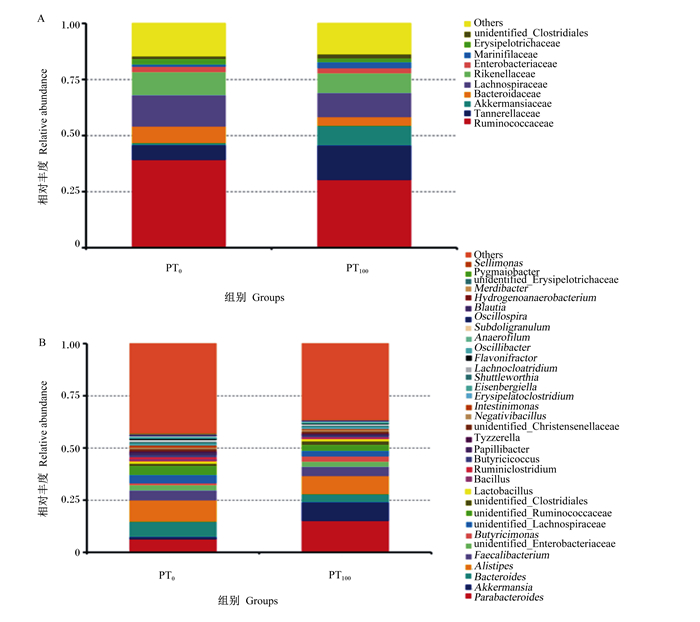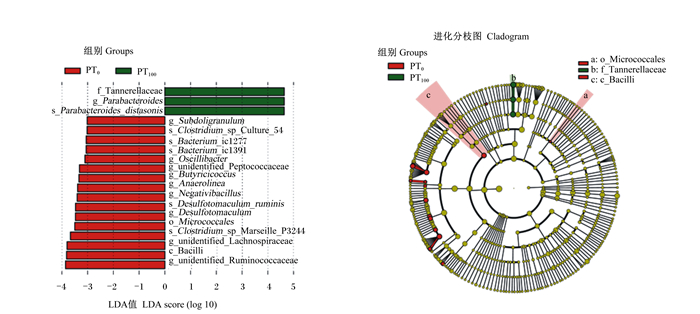2. 扬州大学动物科学与技术学院, 扬州 225009
2. School of Animal Science and Technology, Yangzhou University, Yangzhou 225009, China
近年来,肉鸡行业快速发展,集约化养殖水平得到提高,但现代养殖模式也有肉鸡饲养密度过高、免疫力较弱和生长性能降低等弊端,从而催生肉鸡养殖行业大量使用抗生素,但抗生素会造成畜禽体内残留和蓄积毒素、细菌耐药谱增多等问题。同时,随着我国抗生素禁用的政策实施,会促使家禽生产成本提高。因此,开发天然、低廉、无毒副残留的抗生素替代物已刻不容缓。化香果(Plotytarya strohilacea Sieb. et Zuce)又称化香树果,是胡桃科植物化香树的果序,在我国民间的应用较广且历史悠久,分布广泛,多以叶、果序入药[1]。化香果序中含有较丰富的植物单宁,其单宁属于鞣花单宁(水解单宁),经过水解可以得到鞣花酸。化香果具有特殊的药理学和生物学活性,是其药用价值的基础。国内外对化香果提取的鞣花单宁的研究多集中在抑制细胞毒性、抑制肠道内有害菌、抗氧化、预防癌症、抗衰老[2-3]及其作为复方中药治疗急性、慢性鼻炎和鼻窦炎等方面上[4]。由此可见,化香果单宁具有替代抗生素的潜力,但作为家禽饲料添加剂的研究尚未见报道。因此,本试验旨在研究饲粮添加化香果单宁对肉鸡免疫器官指数、血浆抗氧化和生化指标及盲肠微生物区系的影响,为化香果单宁在家禽生产应用中提供科学依据。
1 材料与方法 1.1 试验设计选择288羽1日龄雄性爱拔益加(AA)肉鸡,随机分为4组,每组6个重复,每个重复12羽。对照组(PT0组)饲喂基础饲粮,试验组分别在基础饲粮中添加100(PT100组)、500(PT500组)和1 000 mg/kg(PT1 000组)化香果单宁(棕褐色,单宁含量≥65%,由中国林业科学研究院林产化学工业研究所植物单宁化学利用课题组提供)。试验期42 d。
1.2 基础饲粮及饲养管理基础饲粮按照NRC(1994)肉鸡营养需求配制并制粒,其组成及营养水平见表 1。试验采用网床平养,网床规格125 cm×95 cm×65 cm。在饲喂期的前3 d,温度控制在34 ℃左右,随后每2 d降低1 ℃,直至温度降至23 ℃左右。所有试验动物均自由采食和饮水。每天采用24 h的光照方法。通风和免疫均按照饲养管理手册标准来执行。
|
|
表 1 基础饲粮组成及营养水平(风干基础) Table 1 Composition and nutrient levels of basal diets (air-dry basis) |
分别在肉鸡21和42日龄时,每个重复随机选取1羽进行屠宰,解剖取出胸腺、脾脏和法氏囊称重,按照公式计算免疫器官指数:

|
分别在肉鸡21和42日龄时,从每重复随机选取1羽,使用肝素钠抗凝采血管,翅静脉采血,4 000 r/min离心10 min,分离得到血浆。测定血浆中谷胱甘肽过氧化物酶(GSH-Px)、过氧化氢酶(CAT)、总超氧化物歧化酶(T-SOD)活性及总抗氧化能力(T-AOC)和丙二醛(MDA)含量。以上指标均使用南京建成生物工程研究所试剂盒测定。
1.3.3 血浆生化指标分别在肉鸡21和42日龄时,采用UniCel DxC 800 Synchron全自动生化分析仪(Beckman Coulter,美国)测定血浆中总胆固醇(T-CHO)、高密度脂蛋白(HDL)、低密度脂蛋白(LDL)、肌酐(CREA)、甘油三酯(TG)、尿素氮(UN)和尿酸(UA)含量,由扬州市疾病预防控制中心测定。
1.3.4 盲肠微生物区系无菌采集各组鸡盲肠内容物,液氮速冻后-80 ℃保存待送样检测。结合本试验肉鸡的免疫器官指数、血浆抗氧化和生化指标结果,决定送检PT0和PT100组肉鸡盲肠内容物样品。由诺禾致源生物信息科技有限公司进行16S rDNA测序。基于Illumina NovaSeq测序平台对V3~V4高变区进行双末端测序,以分析盲肠菌群丰富度和多样性。
1.4 数据处理与统计分析使用Excel 2010对试验数据初步处理,各组之间使用SPSS 26.0进行单因素方差分析(one-way ANOVA)和线性分析,组间采用Duncan氏法多重比较检验。2组之间使用独立样本t检验进行分析。结果用平均值和均值标准误表示,P < 0.05表示显著差异,0.05 < P < 0.10表示有趋势。
2 结果 2.1 饲粮添加化香果单宁对肉鸡免疫器官指数的影响由表 2可知,PT500和PT1 000组21日龄肉鸡的法氏囊指数显著高于PT0和PT100组(P < 0.05)。饲粮添加化香果单宁具有提高21日龄肉鸡的胸腺指数的趋势(P=0.076)。饲粮添加化香果单宁对21和42日龄肉鸡的脾脏指数无显著影响(P>0.05)。
|
|
表 2 饲粮添加化香果单宁对肉鸡免疫器官指数的影响 Table 2 Effects of dietary Plotytarya strohilacea Sieb. et Zuce tannin on immune organ indexes of broilers |
由表 3可知,PT100组42日龄肉鸡的血浆CAT活性显著高于PT0、PT500和PT1 000组(P < 0.05),且血浆CAT活性与化香果单宁添加量呈显著二次曲线相关(P < 0.05)。PT0、PT100和PT500组42日龄肉鸡的血浆GSH-Px活性显著高于PT1 000组(P < 0.05),且血浆GSH-Px活性与化香果单宁添加量呈显著二次曲线相关(P < 0.05)。PT100组42日龄肉鸡的血浆T-AOC显著高于PT0组(P < 0.05),且血浆T-AOC与化香果单宁添加量呈显著线性和二次曲线相关(P < 0.05)。饲粮添加化香果单宁对21和42日龄肉鸡的血浆T-SOD活性和MDA含量无显著影响(P>0.05)。
|
|
表 3 饲粮添加化香果单宁对肉鸡血浆抗氧化指标的影响 Table 3 Effects of dietary Plotytarya strohilacea Sieb. et Zuce tannin on plasma antioxidant indexes of broilers |
由表 4可知,PT100、PT500和PT1 000组42日龄肉鸡的血浆CREA含量显著低于PT0组(P < 0.05),且血浆CREA含量与化香果单宁添加量呈显著线性和二次曲线相关(P < 0.05)。PT100和PT500组21日龄肉鸡的血浆HDL含量显著高于PT0组(P < 0.05)。饲粮添加化香果单宁具有降低42日龄肉鸡的血浆UN(P=0.096)和UA含量(P=0.070)的趋势。饲粮添加化香果单宁对肉鸡血浆T-CHO、LDL和TG含量无显著影响(P>0.05)。
|
|
表 4 饲粮添加化香果单宁对肉鸡血浆生化指标的影响 Table 4 Effects of dietary Plotytarya strohilacea Sieb et Zuce tannin on plasma biochemical indexes of broilers |
由表 5可知,PT100组和PT0组之间Chao1和Simpson指数无显著差异(P>0.05)。
|
|
表 5 盲肠微生物多样性指数 Table 5 Cecal microbial diversity indexes |
由图 1和表 6可知,科水平下的优势菌群(相对丰度>2%)包括:瘤胃菌科(Ruminococcaceae)、坦纳菌科(Tannerellaceae)、阿克曼菌科(Akkermansiaceae)、毛螺旋菌科(Lachnospiraceae)、理研菌科(Rikenellaceae)、拟杆菌科(Bacteroidaceae)、肠杆菌科(Enterobacteriaceae),分别占34.88%、10.86%、4.87%、12.42%、9.48%、5.63%和2.45%。PT100组的盲肠Tannerellaceae相对丰度显著高于PT0组(P<0.05)。

|
Ruminococcaceae:瘤胃菌科;Tannerellaceae:坦纳菌科;Akkermansiaceae:阿克曼菌科;Bacteroidaceae:拟杆菌科;Lachnospiraceae:毛螺旋菌科;Rikenellaceae:理研菌科;Enterobacteriaceae:肠杆菌科;Marinifilaceae:海百合科;unidentified_Clostridiales:未分类梭菌科;Others:其他。Parabacteroides:副拟杆菌属;Akkermansia:阿克曼菌属;Bacteroides:拟杆菌属;Alistipes:另枝菌属;Faecalibacterium:粪杆菌属;unidentified_Enterobacteriaceae:未分类肠杆菌科;Butyricimonas:丁酸弧菌;unidentified_Lachnospiraceae:未分类毛螺菌科;unidentified_Ruminococcaceae:未分类瘤胃菌科;unidentified_Clostridiales:未分类梭菌科;Bilophila:嗜胆菌属;Lactobacillus:乳酸杆菌属;Bacillus:芽孢杆菌属;Ruminiclostridium:瘤胃梭菌属;Butyricicoccus:丁酸球菌属;unidentified_Christensenellaceae:未分类克里斯滕森氏科;Flavonifractor:黄杆菌属;Subdoligranulum:罕见小球菌属;Oscillospira:颤螺菌;Blautia:劳特氏菌属;Hydrogenoanaerobacterium:产氢厌氧杆菌属;unidentified_Erysipelotrichaceae:未分类韦荣球菌科;Acinetobacter:不动杆菌属。 图 1 盲肠微生物相对丰度(A:科水平;B:属水平) Fig. 1 Relative abundance of cecal microbes (A: family level; B: genus level) |
|
|
表 6 科水平和属水平上的优势菌群 Table 6 Dominant flora at family level and genus level |
属水平下的优势菌群(相对丰度>2%)包括:副拟杆菌属(Parabacteroides)、阿克曼菌属(Akkermansia)、另枝菌属(Alistipes)、拟杆菌属(Bacteroides)、粪杆菌属(Faecalibacterium),分别占7.95%、4.59%、9.49%、4.37%和4.64%。PT100组的盲肠副拟杆菌属(Parabacteroides)相对丰度显著高于PT0组(P<0.05)。
2.4.3 组间差异性肠道菌群本试验用线性判别分析(LDA)实现降维和评估差异显著物种的影响大小,LDA阈值设定为3。由图 2可知,PT100组差异优势菌是副拟杆菌,其相对丰度显著高于PT0组(P < 0.05)。

|
Tannerellaceae:坦纳菌科;Parabacteroides:副拟杆菌属;Parabacteroides_distasonis:狄氏副拟杆菌;Subdoligranulum:罕见小球菌属;Bacterium_ic1277:杆菌ic1277;Bacterium_ic1391:杆菌ic1391;Oscillibacter:颤杆菌;unidentified_Peptococcaceae:未分类消化球菌科;Butyricicoccus:丁酸球菌属;Anaerolinea:厌氧绳菌属;Desulfotomaculum_ruminis:瘤胃脱硫肠状菌;Desulfotomaculum:脱硫肠状菌属;Micrococcales:微球菌目;unidentified_Lachnospiraceae:未分类毛螺菌科;Bacilli:杆菌纲;unidentified_Ruminococcaceae:未分类瘤胃菌科。 图 2 组间差异性肠道菌群 Fig. 2 Differential intestinal flora between groups |
前期试验表明,饲粮添加化香果单宁具有提高肉鸡生长性能的趋势[5],但化香果单宁对肉鸡免疫器官的影响还未见有报道。免疫器官指数是评价动物机体免疫水平的指标之一[6]。禽类的免疫器官主要包括脾脏、胸腺和法氏囊。胸腺是细胞免疫的中枢器官,法氏囊是禽类特有的体液免疫器官,在动物健康状态下胸腺和法氏囊指数增大,代表机体的免疫机能增强。本试验结果表明,饲粮添加化香果单宁能够促进肉鸡前期胸腺和法氏囊发育,这与前人研究结果相似。Srikhun等[2]研究表明,植物单宁能够降低肉鸡的法氏囊损伤,有利于免疫器官发育。也有研究表明,饲粮添加橡椀单宁能够提高肉鸡法氏囊和脾脏指数[6]。由此可见,化香果单宁在肉鸡免疫器官发育方面具有一定促进作用。
3.2 饲粮添加化香果单宁对肉鸡血浆抗氧化指标的影响单宁能够有效清除动物体的氧自由基(ROS),且能够提高动物机体的抗氧化酶活性,从而降低机体的氧化应激[7]。CAT是动物机体主要抗氧化酶之一,其具有清除机体的ROS和一氧化氮(NO),保护机体免受氧化应激损伤[8]。GSH-Px在体内能够催化分解过氧化氢,也是机体主要抗氧化酶之一,其有利于保持细胞膜的功能和结构完整性。T-AOC则是反映机体抗氧化系统的综合指标。本试验发现,饲粮添加化香果单宁能够显著提高肉鸡的血浆CAT活性和T-AOC,且血浆CAT活性和T-AOC与化香果单宁添加量呈剂量依赖关系。另外,化香果单宁添加量还与血浆GSH-Px活性呈二次曲线相关,饲粮添加100 mg/kg化香果单宁时血浆GSH-Px活性最高。这与前人研究结果相似,如有研究发现,饲粮添加植物单宁有利于肉鸡抗氧化功能的增强,从而保护脂质的过度氧化[9]。López-Andrés等[10]研究发现,饲粮添加单宁能够提高机体的抗氧化功能。Liu等[11]研究表明,在热应激条件下添加单宁能够显著提高肉兔的血浆T-AOC,降低热应激对机体的影响。Farahat等[12]在肉鸡饲粮中添加植物单宁能够降低其肌肉中MDA含量。Ye等[13]研究发现,饲粮添加单宁具有提高田鼠肝脏中CAT活性的趋势。综上所述,化香果单宁具备较强抗氧化能力,且饲粮添加100 mg/kg化香果单宁时抗氧化效果最佳。
3.3 饲粮添加化香果单宁对肉鸡血浆生化指标的影响血浆生化指标可用于评价动物体的生理和病理状态。T-CHO、HDL、TG和LDL含量均与动物的脂代谢相关[6],TG、HDL和T-CHO均在肝脏内合成。TG是体内广泛存在的脂类,其在肝脏中异常沉积会诱导肝脏巨噬细胞释放炎症因子,导致脂肪肝及肝硬化的发生,若血液中TG含量增多则表明机体发生了代谢性疾病[14]。T-CHO是所有含胆固醇的脂蛋白总和,其与动脉粥样硬化疾病具有相关性[15]。HDL能够抑制LDL的作用,从而减轻心血管疾病的发生[16]。LDL与患心血管疾病率呈正相关[17]。梁萌[18]研究发现,饲粮中添加藤茶提取物(富含多酚)能够降低肉鸡血液LDL和TC含量,能够调节肉鸡脂质代谢,利于肉鸡机体健康。Li等[19]研究表明,饲粮添加多酚能够降低肉鸡血液T-CHO和LDL含量。Zeng等[20]研究发现,单宁能够与血脂水平相关的生物分子结合,从而降低血脂水平。本试验发现,在21日龄时,饲粮添加100和500 mg/kg化香果单宁能够显著提高肉鸡血浆HDL含量,表明化香果单宁能够改善肉鸡前期血浆生化指标,但对肉鸡后期血浆T-CHO、TG和LDL含量均无显著影响。这与前人研究结果[6, 19, 21]并不完全一致,可能是因为试验动物和单宁提取来源等不同所导致的差异,具体原因还需进一步研究。
CREA、UN和UA是动物机体代谢的产物[22]。CREA和UN含量变化与肾小球滤过率相关[23]。肾功能不全时,CREA和UN在体内蓄积,导致血液中两者含量升高,会对组织器官造成毒害[24]。UA是衡量氨基酸利用率和蛋白质分解程度的指标,其含量升高提示机体患有相关疾病(原发性和继发性)[25]。本试验发现,饲粮添加化香果单宁能够降低肉鸡血浆CREA含量,其中以PT100组血浆CREA含量最低,且血浆CREA含量与化香果单宁添加量存在剂量依赖关系。另外,饲粮添加化香果单宁还具有降低血浆UN和UA含量的趋势,提示饲粮条件化香果单宁可能能够提高肉鸡的蛋白质合成和沉积效率,从而有利于动物生产[26]。在结合本试验血浆抗氧化指标结果,推测化香果单宁能够清除机体自由基,维持细胞膜功能和结构完整性,降低组织器官内氧化脂质含量,降低自由基对肾脏和肝脏的损伤,从而降低血浆CREA和UN含量。
3.4 饲粮添加化香果单宁对肉鸡响盲肠微生物区系的影响本试验采用第3代高通量测序技术,3代全长扩增子测序主要通过对16S RNA全长进行扩增,构建SMRT Bell文库,通过分析得到不同样品和分组的群落结构差异,在通过主坐标分析(PCoA)、非加权组平均法(UPGMA)和LefSe等降维图和样品聚类树进行展示。根据本试验免疫器官指数以及血浆抗氧化和生化指标结果,进一步研究了PT0组和PT100组肉鸡盲肠微生物区系的差异。结果发现,饲粮添加100 mg/kg化香果单宁能够显著增加盲肠Parabacteroides相对丰度,其还是肉鸡的优势菌属。目前研究表明,Parabacteroides具有抗炎、调节免疫和代谢功能,有利于机体的健康[27]。Kverka等[28]研究表明,Parabacteroides能够显著降低急性和慢性结肠炎模型小鼠的肠道炎症的严重程度。Koh等[29]研究发现,Parabacteroides能够增加肠道紧密连接蛋白表达,保持肠道屏障的完整性,有利于肠道健康。根据本试验免疫器官指数、血浆抗氧化和生化指标以及前期生长性能[5]的结果,推测化香果单宁是通过增加肠道Parabacteroides相对丰度保持肠道屏障完整性,改善血浆生化指标,从而提高抗氧化功能,促进肉鸡的生长性能。
4 结论饲粮添加化香果单宁能够增加肉鸡盲肠差异优势菌属Parabacteroides相对丰度,提高抗氧化功能,改善血浆生化指标,并且有利于肉鸡免疫器官发育。
| [1] |
徐曼, 汪咏梅, 张亮亮, 等. 化香果提取物体外抑菌活性研究[J]. 生物质化学工程, 2020, 54(2): 15-20. XU M, WANG Y M, ZHANG L L, et al. In vitro antibacterial activity of extract from Platycarya strobilacea Sieb.et Zucc[J]. Biomass Chemical Engineering, 2020, 54(2): 15-20 (in Chinese). DOI:10.3969/j.issn.1673-5854.2020.02.003 |
| [2] |
SRIKHUN T, AENGWANICH W, KONGBUNTAD W. Effects of polyphenols extracted from tamarind (Tamarindus indica L.) seed coat on body weight, white blood cells, bursa of fabricius and NDV-HI titer of broilers under chronic heat stress[J]. International Journal of Poultry Science, 2010, 9(10): 988-995. DOI:10.3923/ijps.2010.988.995 |
| [3] |
ABU HAFSA S H, IBRAHIM S A. Effect of dietary polyphenol-rich grape seed on growth performance, antioxidant capacity and ileal microflora in broiler chicks[J]. Journal of Animal Physiology and Animal Nutrition, 2018, 102(1): 268-275. DOI:10.1111/jpn.12688 |
| [4] |
高蓉. 化香树果序活性成分提取、分离、应用及动力学研究[D]. 博士学位论文. 西安: 西北大学, 2009: 23-121. GAO R. Studies on extraction and isolation of active ingredients from Platycarya strobilacea Sieb. et Zucc as well as relative dynamics and its application[D]. Ph. D. Thesis. Xi'an: Northwest University, 2009: 23-121. (in Chinese) |
| [5] |
从光雷, 肖蕴祺, 张倩雲, 等. 饲粮添加化香果单宁对肉鸡生长性能、屠宰性能、器官指数、肉品质、抗氧化功能和肠道发育的影响[J]. 动物营养学报, 2021, 33(5): 2661-2671. CONG G L, XIAO Y Q, ZHANG Q Y, et al. Effects of Plotytarya strohilacea Sieb. et Zuce tannin on growth performance, slaughter performance, organ indexes, meat quality, antioxidant function and intestinal development of broilers[J]. Chinese Journal of Animal Nutrition, 2021, 33(5): 2661-2671 (in Chinese). |
| [6] |
从光雷, 肖蕴祺, 张倩雲, 等. 饲粮添加橡椀单宁对肉鸡生长性能、免疫器官指数和血浆生化指标的影响[J]. 动物营养学报, 2021, 33(5): 2652-2660. CONG G L, XIAO Y Q, ZHANG Q Y, et al. Effects of dietary Quercus acutissima Carruth tannin on growth performance, immune organ indexes and plasma biochemical indexes of broilers[J]. Chinese Journal of Animal Nutrition, 2021, 33(5): 2652-2660 (in Chinese). |
| [7] |
从光雷, 王强, 肖蕴祺, 等. 饲粮添加橡椀单宁对肉鸡生长性能、屠宰性能、肉品质、抗氧化功能和肠道发育的影响[J]. 动物营养学报, 2020, 32(12): 5948-5957. CONG G L, WANG Q, XIAO Y Q, et al. Effects of dietary Quercus acutissima Carruth tannin on growth performance, slaughter performance, meat quality, antioxidant function and intestinal development of broilers[J]. Chinese Journal of Animal Nutrition, 2020, 32(12): 5948-5957 (in Chinese). |
| [8] |
WEYDERT C J, CULLEN J J. Measurement of superoxide dismutase, catalase and glutathione peroxidase in cultured cells and tissue[J]. Nature Protocols, 2010, 5(1): 51-66. DOI:10.1038/nprot.2009.197 |
| [9] |
CHAMORRO S, VIVEROS A, CENTENO C, et al. Effects of dietary grape seed extract on growth performance, amino acid digestibility and plasma lipids and mineral content in broiler chicks[J]. Animal, 2013, 7(4): 555-561. DOI:10.1017/S1751731112001851 |
| [10] |
LÓPEZ-ANDRÉS P, LUCIANO G, VASTA V, et al. Dietary quebracho tannins are not absorbed, but increase the antioxidant capacity of liver and plasma in sheep[J]. The British Journal of Nutrition, 2013, 110(4): 632-639. DOI:10.1017/S0007114512005703 |
| [11] |
LIU H W, DONG X F, TONG J W, et al. A comparative study of growth performance and antioxidant status of rabbits when fed with or without chestnut tannins under high ambient temperature[J]. Animal Feed Science and Technology, 2011, 164(1/2): 89-95. |
| [12] |
FARAHAT M H, ABDALLAH F M, ALI H A, et al. Effect of dietary supplementation of grape seed extract on the growth performance, lipid profile, antioxidant status and immune response of broiler chickens[J]. Animal, 2017, 11(5): 771-777. DOI:10.1017/S1751731116002251 |
| [13] |
YE M H, NAN Y L, DING M M, et al. Effects of dietary tannic acid on the growth, hepatic gene expression, and antioxidant enzyme activity in Brandt's voles (Microtus brandti)[J]. Comparative Biochemistry and Physiology.Part B, Biochemistry & Molecular Biology, 2016, 196/197: 19-26. |
| [14] |
KARANJIA R N, CROSSEY M M E, COX I J, et al. Hepatic steatosis and fibrosis: non-invasive assessment[J]. World Journal of Gastroenterology, 2016, 22(45): 9880-9897. DOI:10.3748/wjg.v22.i45.9880 |
| [15] |
马维英, 王爽, 沈军达, 等. 饲粮胆碱水平对绍兴鸭脂质代谢的影响[J]. 畜牧兽医学报, 2014, 45(2): 233-242. MA W Y, WANG S, SHEN J D, et al. Effect of choline level in diet on lipid metabolism in Shaoxing ducks during the initial egg-laying period[J]. Acta Veterinaria et Zootechnica Sinica, 2014, 45(2): 233-242 (in Chinese). |
| [16] |
勾蓝图, 傅明德. HDL抗动脉粥样硬化的作用[J]. 国外医学(心血管疾病分册), 2004, 31(3): 150-152. GOU L T, FU M D. HDL anti-atherosclerosis effect[J]. Foreign Medical Sciences (Section of Cardiovascular Disease), 2004, 31(3): 150-152 (in Chinese). DOI:10.3969/j.issn.1673-6583.2004.03.008 |
| [17] |
袁志敏. 低低密度脂蛋白胆固醇及血压与冠状动脉粥样硬化间关系[J]. 心血管病学进展, 2010, 31(3): 488. YUAN Z M. The relationship between low-low-density lipoprotein cholesterol, blood pressure and coronary atherosclerosis[J]. Advances in Cardiovascular Diseases, 2010, 31(3): 488 (in Chinese). |
| [18] |
梁萌. 藤茶提取物对肉鸡免疫性能、脂质过氧化水平和脂类代谢的影响[D]. 硕士学位论文. 泰安: 山东农业大学, 2004: 33-46. LIANG M. Effects of Ampelopsis grossedentata flavonoids on the immune function, antioxidation level and lipid metabolism of broiler chickens[D]. Master's Thesis. Taian: Shandong Agricultural University, 2004: 33-46. (in Chinese) |
| [19] |
LI H L, LI Z J, WEI Z S, et al. Long-term effects of oral tea polyphenols and Lactobacillus brevis M8 on biochemical parameters, digestive enzymes, and cytokines expression in broilers[J]. Journal of Zhejiang University-Science B, 2015, 16(12): 1019-1026. DOI:10.1631/jzus.B1500160 |
| [20] |
ZENG X Q, SHENG Z T, LI X X, et al. In vitro studies on the interactions of blood lipid level-related biological molecules with gallic acid and tannic acid[J]. Journal of the Science of Food and Agriculture, 2019, 99(15): 6882-6892. DOI:10.1002/jsfa.9974 |
| [21] |
徐晓娟, 蔡海莹, 张磊, 等. 日粮中添加茶多酚对青脚麻鸡生长性能、胴体品质和血脂的影响[J]. 中国饲料, 2011(10): 30-33, 40. XU X J, CAI H Y, ZHANG L, et al. Effects of tea polyphenols added in diets on growth performance, carcass quality and serum lipid in broilers[J]. China Feed, 2011(10): 30-33, 40 (in Chinese). DOI:10.3969/j.issn.1004-3314.2011.10.009 |
| [22] |
熊琳, 朱婷婷, 张丽玲, 等. 慢性肾病大鼠血管钙化与骨代谢标志物的相关性研究[J]. 中国比较医学杂志, 2021, 31(1): 87-94. XIONG L, ZHU T T, ZHANG L L, et al. Correlation between vascular calcification and bone metabolism markers in rats with chronic kidney disease[J]. Chinese Journal of Comparative Medicine, 2021, 31(1): 87-94 (in Chinese). |
| [23] |
迟雁青, 刘琼, 林海英, 等. 血肌酐、血尿素氮评价慢性肾脏病患者肾功能时与年龄的相关性研究[J]. 中国临床实用医学, 2009, 3(5): 36-38. CHI Y Q, LIU Q, LIN H Y, et al. The study of associativity with renal function and serum creatinine, serum urea nitrogen in different age stages of the chronic kidney disease patients[J]. China Clinical Practical Medicine, 2009, 3(5): 36-38 (in Chinese). DOI:10.3760/cma.j.issn.1673-8799.2009.05.19 |
| [24] |
梁友军, 马天寿, 张红燕. 血液透析联合灌流与血液透析滤过治疗终末期肾功能衰竭的比较分析[J]. 中国医药指南, 2013(16): 229-230. LIANG Y J, MA T S, ZHANG H Y. Comparative analysis of hemodialysis combined perfusion and hemodiafiltration in the treatment of end-stage renal failure[J]. Guide of China Medicine, 2013(16): 229-230 (in Chinese). DOI:10.3969/j.issn.1671-8194.2013.16.168 |
| [25] |
DONSBOUGH A L, POWELL S, WAGUESPACK A, et al. Uric acid, urea, and ammonia concentrations in serum and uric acid concentration in excreta as indicators of amino acid utilization in diets for broilers[J]. Poultry Science, 2010, 89(2): 287-294. DOI:10.3382/ps.2009-00401 |
| [26] |
YANG J Y, ZHANG H J, WANG J, et al. Effects of dietary grape proanthocyanidins on the growth performance, jejunum morphology and plasma biochemical indices of broiler chicks[J]. Animal, 2017, 11(5): 762-770. DOI:10.1017/S1751731116002056 |
| [27] |
WANG K, LIAO M F, ZHOU N, et al. Parabacteroides distasonis alleviates obesity and metabolic dysfunctions via production of succinate and secondary bile acids[J]. Cell Reports, 2019, 26(1): 222-235. DOI:10.1016/j.celrep.2018.12.028 |
| [28] |
KVERKA M, ZAKOSTELSKA Z, KLIMESOVA K, et al. Oral administration of Parabacteroides distasonis antigens attenuates experimental murine colitis through modulation of immunity and microbiota composition[J]. Clinical and Experimental Immunology, 2011, 163(2): 250-259. DOI:10.1111/j.1365-2249.2010.04286.x |
| [29] |
KOH G Y, KANE A V, WU X, et al. Parabacteroides distasonis attenuates tumorigenesis, modulates inflammatory markers and promotes intestinal barrier integrity in azoxymethane-treated A/J mice[J]. Carcinogenesis, 2020, 41(7): 909-917. DOI:10.1093/carcin/bgaa018 |




